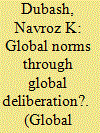| Srl | Item |
| 1 |
ID:
088080


|
|
|
|
|
| Publication |
2009.
|
| Summary/Abstract |
In recent years, global "deliberative processes" bringing together government, civil society, and private sector actors have become increasingly common on the global stage. Past work on these processes has either read them as relatively unproblematic consensus-building exercises, or exercises in global corporatism. Using a case study of the World Commission on Dams, this article explores how formal global deliberative processes can be a strategy for global norm formation and legitimation. It suggests that global deliberation can indeed be a vehicle for emergence and propagation of norms, but that these processes face multiple challenges that are structural in nature. Three factors are identified as key elements in understanding norm emergence through global deliberation: the legitimacy of global deliberation linked to questions of representation and democratic procedure; the micropolitics of norm emergence; and the process through which incipient norms are institutionalized by states.
|
|
|
|
|
|
|
|
|
|
|
|
|
|
|
|
| 2 |
ID:
106541


|
|
|
|
|
| Publication |
2011.
|
| Summary/Abstract |
The construction of large dams continues apace in many developing countries. This is no more evident than in China, where half of the world's large dams are now located. A decade ago the World Commission on Dams released its review of large dams around the world. The report provided a framework for the decision-making of governments, donors, policymakers, planners, and dam builders across seven strategic priorities: to gain acceptance; assess options; address existing dams; sustain rivers and livelihoods; recognize entitlements and secure benefits; ensure compliance; and share rivers across boundaries. Using the strategic priorities as a frame for analysis, this article reviews the progress made by the Chinese government over the last 10 years with respect to addressing the human casualties of large dam construction. It identifies specific frailties and strengths in Chinese policy and practice. It suggests that a stakeholder satisfaction model that places the affected population at the centre of the accountability structure would ensure that those who are tasked with the administration of resettlement policies are answerable to the affected people. In this way, resettlement from large dams can become truly people-centred.
|
|
|
|
|
|
|
|
|
|
|
|
|
|
|
|